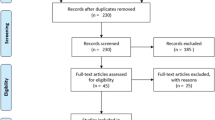Abstract
Children diagnosed with autism spectrum disorder (ASD) often engage in low levels of peer social interactions; therefore, we often need to explicitly teach these skills. In the current study, we implemented a combined tactile and textual prompt, delivered via a text message sent to an Apple Watch®, to prompt social initiations from children with ASD to peers during free play. Results showed that the text message prompts increased the frequency of independent social initiations for both participants. Furthermore, 1 participant continued to emit high levels of independent social initiations during a 1-month follow-up with no prompts.


Similar content being viewed by others
References
American Psychiatric Association. (2013). Diagnostic and statistical manual of mental disorders (5th ed.). Arlington, VA: American Psychiatric Publishing.
Anson, H., Todd, J., & Cassaretto, K. (2008). Replacing overt verbal and gestural prompts with unobtrusive covert tactile prompting for students with autism. Behavior Research Methods, 40(4), 1106–1110. https://doi.org/10.3758/BRM.40.4.1106.
Gena, A. (2006). The effects of prompting and social reinforcement on establishing social interactions with peers during the inclusion of four children with autism in preschool. International Journal of Psychology, 41(6), 541–554. https://doi.org/10.1080/00207590500492658.
Goldsmith, T. R., & LeBlanc, L. A. (2004). Use of technology in interventions for children with autism. Journal of Early and Intensive Behavior Intervention, 1(2), 166–178. https://doi.org/10.1037/h0100287.
Grosberg, D., & Charlop, M. (2017). Teaching conversational speech to children with autism spectrum disorder using text-message prompting. Journal of Applied Behavior Analysis, 9999, 9999), 1–9999),16. https://doi.org/10.1002/jaba.403.
Groskreutz, M. P., Peters, A., Groskreutz, N. C., & Higbee, T. S. (2015). Increasing play-based commenting in children with autism spectrum disorder using a novel script-frame procedure. Journal of Applied Behavior Analysis, 48(2), 442–447. https://doi.org/10.1002/jaba.194.
Krantz, P. J., & McClannahan, L. E. (1993). Teaching children with autism to initiate to peers: Effects of a script-fading procedure. Journal of Applied Behavior Analysis, 26(1), 121–132. https://doi.org/10.1901/jaba.1993.26-121.
Krantz, P. J., & McClannahan, L. E. (1998). Social interaction skills for children with autism: A script-fading procedure for beginning readers. Journal of Applied Behavior Analysis, 31(2), 191–202. https://doi.org/10.1901/jaba.1998.31-191.
Ledbetter-Cho, K., Lang, R., Davenport, K., Moore, M., Lee, A., Howell, A., . . . O’Reilly, M. (2015). Effects of script fading on the peer-to-peer communication of children with autism spectrum disorder. Journal of Applied Behavior Analysis, 48(4), 785–799. doi:https://doi.org/10.1002/jaba.240
McDonald, M. E., & Hemmes, N. S. (2003). Increases in social initiation toward an adolescent with autism: Reciprocity effects. Research in Developmental Disabilities, 24(6), 453–465. https://doi.org/10.1016/j.ridd.2003.04.001.
Memari, A. H., Panahi, N., Ranjbar, E., Moshayedi, P., Shafiel, M., Kordi, R., & Ziaee, V. (2015). Children with autism spectrum disorder and patterns of participation in daily physical and play activities. Neurological Research International. https://doi.org/10.1155/2015/531906.
Peić, D., & Hernández, V. (2016). Countee - Data collection system for behavioral data (1.0.4) [Mobile application software]. Retrieved from https://itunes.apple.com
Rubin, K., Coplan, R., & Bowker, J. (2009). Social withdrawal in childhood. Annual Review of Psychology, 60(1), 141–171. https://doi.org/10.1146/annurev.psych.60.110707.163642.
Shabani, D., Katz, R., Wilder, D., Beauchamp, K., Taylor, C., & Fischer, K. (2002). Increasing social initiations in children with autism: Effects of a tactile prompt. Journal of Applied Behavior Analysis, 35(1), 79–83. https://doi.org/10.1901/jaba.2002.35-79.
Taylor, B., & Levin, L. (1998). Teaching a student with autism to make verbal initiations: Effects of a tactile prompt. Journal of Applied Behavior Analysis, 31(4), 651–654. https://doi.org/10.1901/jaba.1998.31-651.
Tzanakaki, P., Grindle, C., Dungait, S., Hulson-Jones, A., Saville, M., Hughes, J. C., & Hastings, R. P. (2014). Use of a tactile prompt to increase social initiations in children with autism. Research in Autism Spectrum Disorders, 8(6), 726–736. https://doi.org/10.1016/j.rasd.2014.03.016.
Wichnick-Gillis, A. M., Vener, S. M., & Poulson, C. L. (2016). The effect of a script-fading procedure on social interactions among young children with autism. Research in Autism Spectrum Disorders, 26, 1–9. https://doi.org/10.1016/j.rasd.2016.03.004.
Acknowledgements
This project was completed in partial fulfillment of the master’s degree from California State University, Stanislaus, by the first author. This study was supported in part by a Student Engagement in Research, Scholarship, and Creative Activity Mini-grant from California State University, Stanislaus. We thank Haide Rocha and Cecilia Schaffner for their assistance in collecting data.
Author information
Authors and Affiliations
Corresponding author
Ethics declarations
Conflict of Interest
The authors declare that they have no conflict of interest.
Ethical Approval
All procedures performed in studies involving human participants were in accordance with the ethical standards of the institutional committee (Psychology Institutional Review Board, CSU Stanislaus, P-F17-72) and with the 1964 Helsinki declaration and its later amendments or comparable ethical standards.
Informed Consent
Informed consent was obtained from all individual participants included in the study.
Additional information
Publisher’s Note
Springer Nature remains neutral with regard to jurisdictional claims in published maps and institutional affiliations.
Research Highlights
• Clinicians can teach children to respond to text-message prompts during brief, individual sessions.
• Utilizing technology (e.g., cell phones and smart watches) may allow clinicians to deliver less intrusive prompts in play contexts.
• Text-message prompts permit clinicians to deliver specific, contextually appropriate prompts.
• Smart watches are common, socially acceptable stimuli that may be ideal mechanisms to deliver prompts naturalistically.
Rights and permissions
About this article
Cite this article
Lopez, A.R., Wiskow, K.M. Teaching Children With Autism to Initiate Social Interactions Using Textual Prompts Delivered via Apple Watches®. Behav Analysis Practice 13, 641–647 (2020). https://doi.org/10.1007/s40617-019-00385-y
Published:
Issue Date:
DOI: https://doi.org/10.1007/s40617-019-00385-y




